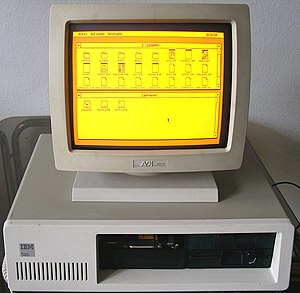Application Environment Service
 |
|

PC running GEM desktop in EGA on a monochome monitor.
|
|
| Developer(s) | Digital Research, Inc. / Lee Jay Lorenzen |
|---|---|
| Initial release | February 28, 1985 |
| Stable release |
GEM/3 3.11 / November 3, 1988
|
| Development status | Historic |
| Type | Windowing system |
| License | GPL |
| Website | www |
Graphics Environment Manager (GEM) was an operating environment created by Digital Research (DRI) for use with the DOS operating system on Intel 8088 and Motorola 68000 microprocessors.
GEM is known primarily as the graphical user interface (GUI) for the Atari ST series of computers, and was also supplied with a series of IBM PC-compatible computers from Amstrad. It also was available for standard IBM PC, at the time when the 6 MHz IBM PC AT (and the very concept of a GUI) was brand new. It was the core for a small number of DOS programs, the most notable being Ventura Publisher. It was ported to a number of other computers that previously lacked graphical interfaces, but never gained popularity on those platforms. DRI also produced X/GEM for their FlexOSreal-time operating system with adaptations for OS/2 Presentation Manager and the X Window System under preparation as well.
GEM started life at DRI as a more general purpose graphics library known as GSX (Graphics System Extension), written by a team led by Don Heiskell. Lee Lorenzen (at Graphic Software Systems, Inc.) who had recently left Xerox PARC (birthplace of the GUI) wrote much of the code. GSX was essentially a DRI-specific implementation of the GKS graphics standard proposed in the late 1970s. GSX was intended to allow DRI to write graphics programs (charting, etc.) for any of the platforms CP/M-80, CP/M-86 and MS-DOS (NEC APC-III) would run on, a task that would otherwise require considerable effort to port due to the large differences in graphics hardware (and concepts) between the various systems of that era.
...
Wikipedia
